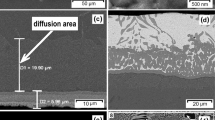Conclusions
During sintering the presence of a titanium hydride addition in a high-zinc brass powder promotes the reduction of the starting oxide films, prevents further oxidation, inhibits the evaporation of zinc, and decreases the thickness of the defective surface layer. As a result, mechanical properties are improved, the improvement being greatest in the sintering of an oxidized brass powder in an only partially dried atmosphere. Use of titanium hydride is not recommended in cases where high electrical and thermal conductivities and good polishing ability are required in sintered brass parts.
Similar content being viewed by others
Literature cited
E. Paller and D. Grimme, “Investigation into the feasibility of producing P/M brass parts,” in: New Materials Produced by Powder Metallurgy Methods [Russian translation], Metallurgiya, Moscow (1966), pp. 137–146.
F. Eisenkolb, Die neuere Entwicklung der Pulvermetallurgie, VEB Verlag Technik, Berlin.
G. K. Gaiduchenko, Sintered Constructional Materials [in Russian], Inst. Probl. Materialoved., Akad. Nauk Ukr. SSR, Kiev (1983), pp. 33–42.
A. B. Medvedovskii, O. S. Nichiporenko, and Yu. I. Naida, “Method of processing of iron base powder,” Inventor's Certificate No. 692695, Otkr. Izobret., No. 39 (1979).
G. E. Mazharova and G. K. Gaiduchenko, “Effect of titanium hydride on the volatility of zinc in the manufacture of blanks from an atomized brass powder,” in: Sintered Constructional, Bearing, and Frictional Materials [in Russian], Inst. Probl, Materialoved., Akad. Nauk Ukr. SSR, Kiev (1985), pp. 51–54.
I. D. Radomysel'skii, G. K. Gaiduchenko, et al., “Effect of atomization conditions on the quality of brass powder,” Poroshk. Metall., No. 7, 1–4 (1983).
Ya. G. Goroshchenko, The Chemistry of Titanium [in Russian], Naukova Dumka, Kiev (1970).
Metallic Hydrides [in Russian], Atomizdat, Moscow (1973).
G. F. Kobzenko, S. P. Pas'ko, M. V. Chubenko, and A. A. Shkola, “Effect of environment on the thermal stability of titanium hydride,” Metallofizika, 4, No. 6 (1982).
W. Heine and U. Zwicker, “Beitrag zur Konstitution von Zink-Kupfer-Titan Legierungen,” Z. Metallk., 53, No. 56, 386–388 (1962).
Author information
Authors and Affiliations
Additional information
Deceased.
Translated from Poroshkovaya Metallurgiya, No. 5(281), pp. 34–39, May, 1986.
Rights and permissions
About this article
Cite this article
Radomysel'skii, I.D., Gaiduchenko, G.K., Mazharova, G.E. et al. Use of titanium hydride in the sintering of parts from an atomized high-zinc brass powder. Powder Metall Met Ceram 25, 382–387 (1986). https://doi.org/10.1007/BF00813950
Received:
Issue Date:
DOI: https://doi.org/10.1007/BF00813950




